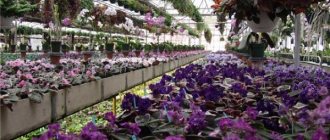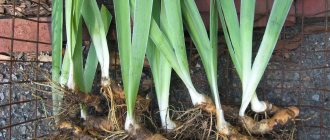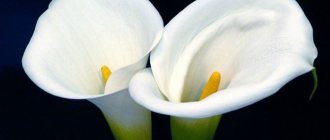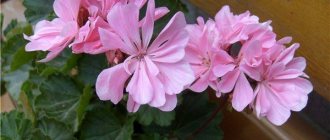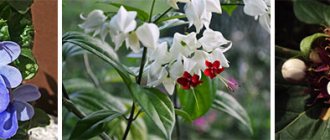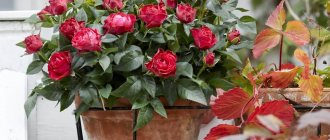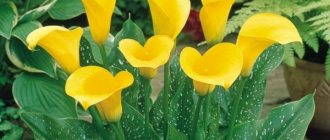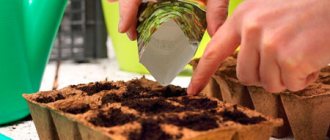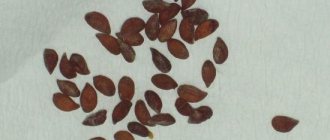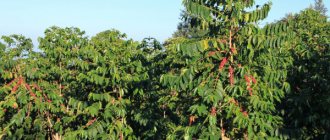Common oleander is the only species representing the Kutrov family. This is an evergreen shrub, which has been valued since ancient times for the beauty of its delicate inflorescences. Wild specimens can be found in subtropical areas - in northern Africa and southern China, Transcaucasia and Portugal. Cultivated varieties are grown as indoor flowers and are also widely used in landscape design.
Description of oleander
Under favorable conditions, a spreading oleander bush can grow up to 2-3 meters in height.
Straight flexible branches of a brownish color are covered with rounded lenticels.
Narrow lanceolate leaves with a dense leathery surface reach a length of 15 cm. The width of the leaf plate does not exceed 3 cm.
A light, clearly defined midrib runs through the middle of the leaf, with frequent transverse stripes extending from it.
Inflorescences are grouped at the ends of the shoots. Varieties with five-petal corollas are more common, but breeders have bred many varieties with double flowers. The color is varied: from white and pale pink to dark red or burgundy.
Oleander blooms for a long time - from late May to mid-autumn.
In place of the pollinated flower, a leaflet fruit appears. The valves of the long (up to 10 cm) pod contain many small seeds with feathery tufts.
A properly formed bush looks elegant; the flowers exude a caramel or almond aroma.
The shrub is moisture-loving, but can withstand heat and even short-term drought.
But such a beautiful plant cannot always be kept at home. All above-ground parts and the root of the oleander are poisonous. The flower should not be kept in a house where small children or animals live.
Kinds
Common oleander / Nerium oleander
Other options for the name of the species are fragrant oleander (Nerium odorum) or Indian oleander (Nerium indicum) . This is a large shrub that grows up to 4 m in height. The branches are straight, lanceolate-shaped leaves are attached to short petioles or in whorls of 3 leaves, or opposite; the leaves reach 15 cm in length and three in width; the underside of the leaf blade is light green, and the upper side is darker; leathery to the touch. Inflorescences grow in clusters. Large flowers of red, pink, white, yellow cover the inflorescences quite densely. There are forms with variegated flowers.
- Aphelandra at home: care and types
Varieties of oleander with photos and names
Varieties of decorative garden crops differ mainly in the color of the petals. Each variety has an attractive color. Pink shades are more common (from pale pink to deep crimson).
White
White terry oleander is a bush with lush inflorescences of a milky white color. The aroma is light and pleasant. The leaves are dark green, smoothly colored.
The Mont Blanc variety with snow-white corollas is distinguished by abundant and long-lasting flowering.
Yellow
Less common are varieties with yellow flowers. These are the varieties “Soleil Dor”, “Maria Gambetta”, “Flavestsene”.
Double lemon yellow oleander is a medium sized shrub. The flowers are bell-shaped.
Red
The common oleander has scarlet and crimson-red umbrella inflorescences.
Red flowers predominate in the varieties Algier, Etna, Alassio, Agnes Duras.
Other varieties of common oleander
Hybrid varieties have an unusual and bright coloring:
- Scarlet is a variegated variety, crimson petals are dotted with thin white stripes;
- Star of Persia is a variegated variety, the flower with a yellow center along the edges has a peach tint;
- Fragrant oleander is a low bush (up to 50cm), which is often grown in tubs and flowerpots; flowers are solitary, not collected in inflorescences;
- Indian oleander is a giant among shrubs, reaching four meters in height; flowers with a sweet aroma and bright colors (pink, red, yellow).
Caring for oleander at home
Oleander does not belong to the category of capricious plants. It's easy to care for. The main thing is to provide sufficient lighting.
Location and lighting
Oleander grows well on insulated balconies, loggias and enclosed verandas. Sometimes flowerpots with plants are placed in residential areas. In this case, it is better to place the flower in a corner by the window. You should not keep oleander in the bedroom, its aroma can cause headaches.
In order for the bush to bloom earlier, it needs to be provided with sufficient sunlight. It is better to place the pot on the south or southeast side of the house. If this is not possible, additional artificial lighting will be required. For this purpose, it is better to use economical fluorescent lamps.
In April-May, you can take the flower outside, where there will be more sunlight.
In the southern regions of Russia, oleander feels great in open ground.
The plant is not burned by direct sunlight, but if the flower was in a shaded place, it should be accustomed to the sun gradually.
Temperature
In spring and summer, conditions will be comfortable from +20ºС to +30ºС. The heat-loving plant does not tolerate temperature changes and cold drafts.
During the winter dormancy period, the optimal temperature will be from +8ºС to +15ºС.
The shrub is able to withstand short-term frosts with temperatures dropping to -10ºС.
Watering
Oleander is a moisture-loving plant. In nature, oleander thickets are more often found along the banks of rivers and streams.
In summer, indoor flowers are watered daily. In hot weather, you don’t have to pour the liquid out of the pan. Tap water should sit in an open container for at least 24 hours.
In winter, moderate watering is needed. At the same time, the earthen coma should not be allowed to dry out. The water in the pan should not stagnate, otherwise the roots will rot.
Bathing and spraying
If dust does not accumulate on the leaves, it is recommended to bathe the plant once a month. In winter, the air becomes dry, so you need to regularly spray the leaves with a spray bottle.
In summer, shrubs growing outside do not need to be sprayed.
Top dressing
At the beginning of the growing season, it is necessary to add mineral and organic fertilizers to the soil. In spring, the flower is fed 2-3 times a month. If there is abundant flowering, it is necessary to fertilize the soil weekly. The soil must first be well moistened.
It is not recommended to fertilize in hot weather. You can use any fertilizer for flowering plants.
Oleander pruning and crown formation
To ensure that the branches do not stretch and the flowering is abundant and long, it is important to form the crown correctly.
Sanitary pruning should be carried out annually in spring or autumn. A radical rejuvenation procedure is carried out every 3-4 years.
Spring pruning is carried out when buds have not yet appeared on the stems. The branches are shortened by half (and sometimes by 2/3), which stimulates the development of new shoots. Young shoots produce larger inflorescences.
When grown in the ground, overgrown bushes are pruned to the stump. This procedure is carried out in late autumn or early spring. All shoots are removed, leaving 15-18 cm stumps. Large cuts must be treated with garden putty.
This pruning method is not suitable for young plants, since their root system is not formed. Old and weak plants should be pruned with caution.
By properly shaping a young plant, you can get a slender flowering tree.
Care should be taken when working. You need to wear gloves and avoid getting the juice in your eyes.
What to do when the oleander has faded?
As they wither, the clusters with double flowers take on an unattractive appearance. In addition, fungi and mites grow faster in them. Dried inflorescences are cut off with garden shears, which are best treated with alcohol or vodka.
Varieties with simple flowers are easier to care for: wilted corollas fall off on their own.
There is no need to rush and cut off the peduncle; new buds may appear on it.
Vegetative shoots growing under flower buds should be removed - they slow down the growth and development of the flower.
Rest period
For the winter, the oleander can be moved indoors. If it is not possible to install the tub away from heat sources, you will have to organize additional humidification. You can place an aquarium or a container of water nearby.
Without good lighting (at least 10 hours a day), the plant may lose its leaves; flowering next year will be sparse.
In the southern regions of Russia, the shrub overwinters in the garden. If a sharp cold snap to sub-zero temperatures is expected, the plant must be covered.
What is important to know about the plant
Oleander was very popular in ancient times, as evidenced by wall paintings in Pompeii and Rome. Mention of the plant is found in wall paintings on the island. Crete, dating back to the 14th century. BC e. Even then, the medicinal properties and poisonous effect of oleander were known. Scientific research has confirmed practical experience of folk use.
Virulence
The plant contains cardiac glycosides oleandrin, neandrin and cornerin. Therefore, it is not recommended to keep oleander at home if there are children in the family.
The juice of leaves and flowers, when ingested, causes severe abdominal cramps, diarrhea, and vomiting. Then the functioning of the heart and central nervous system is disrupted. A large dose of oleander glycosides can cause cardiac arrest.
It is not only ingestion that is harmful. The sap of the plant causes irritation if it comes into contact with the skin.
Medicinal properties
The ancient Egyptians and Greeks used pink laurel for medicinal purposes and used it as an antidote for snake bites. Dioscurides, Theophrastus, and Pliny the Elder wrote about the healing properties of the oleander plant. Later it turned out that the glycoside oleandrin is effective against heart disease. They began to produce medicines from the leaves of the plant, but then their production ceased in Russia.
The problem with using oleander independently is the inability to accurately dose glycosides. These are substances with multiple effects. They can cure, but they can also destroy a person or pet.
Oleander transplant
It is recommended to replant young plants every spring. If the bush is actively developing, replanting is needed twice a year.
Shoots planted in small containers in the fall are planted in larger pots in the spring.
An adult bush is replanted every 2-3 years in the spring. If the root system has grown and filled the entire pot, it is better to do an extraordinary transshipment. You can remove the top layer of soil and add fresh substrate.
It is recommended to trim the roots by sprinkling them with charcoal. This has a beneficial effect on flowering.
Pot
For oleander, it is better to choose simple earthenware of the appropriate size. A bush or tree grows well in a wooden box. Mandatory conditions are the presence of a drainage hole and a tray.
When transplanting, you need to choose a larger container. The diameter of the new pot should be 4-5cm larger.
The soil
Oleander is not very sensitive to fluctuations in the PH environment. Flower growers recommend using loamy soil. For replanting, a mixture of turf (2 parts), leaf soil (1 part), peat (1 part) and coarse river sand (1 part) is suitable. You can add some horn shavings.
Good garden soil with added sand is often used.
Oleander propagation
Propagation using cuttings
This is the easiest way. Planting material - shoots 10-15 cm long, obtained during the formation of the bush. The sections should be sprinkled with charcoal and then dried.
It is better to root the shoot in perlite, crushed expanded clay or sand with the addition of charcoal. Do not over-moisten the substrate so that the cuttings do not rot.
The pot should be placed in a bright place. It is important to avoid drafts and maintain the temperature within +18-22ºС.
You can put the stems in a jar of water, having first dissolved a couple of tablets of activated carbon. After 3-4 weeks, roots will appear, and the petioles are ready for planting in a nutritious soil mixture.
Reproduction using air layering
This method is reliable, but more labor-intensive. On the young stem, make 2 circular cuts at a distance of 10-12 cm from the top. A strip of bark 1.5-2 cm wide is removed. Then a glass tube is put on the branch and sealed on one side with a cork and wax. Water is poured into the tube and the other end is sealed.
You can add a rooting agent to the water. In a nutrient medium, roots develop quickly. After this, the branch with roots is cut off and planted in a separate container. The advantage of this method is that rooting occurs on the mother culture. Such seedlings are more resilient.
Propagation using seeds
Seeds for propagation must be fresh. During long-term storage, germination rate decreases.
The seed must be etched in a slightly pink solution of potassium permanganate for 30-40 minutes. Then soak in warm water for 1.5-2 hours.
The treated seeds are transferred to prepared sand and turf soil, sprinkled with a thin layer of earth and covered with film. For better germination, you need to provide favorable conditions: temperature +30-35ºС and long daylight hours.
Grown seedlings with 3-4 leaves are planted in separate pots.
Growing from seeds is not always effective, since their germination rate is extremely low.
Dividing the bush
This method is used when transplanting overgrown shrubs. The plant is removed from the tub and the roots are carefully removed from the ground. If the root system is healthy and there are many growth points on the shoots, the bush is divided into 2-4 parts using a sharp knife. All wounds should be sprinkled with ash or activated carbon powder. After drying the rhizome in air, it is placed in a planting container of a suitable size.
Diseases and pests of oleander
Manifestations of diseases are noticeable in appearance:
- The most common problem is drying out leaves. The reason is lack of moisture. It is necessary to adjust watering and spray the foliage regularly.
- If the leaves turn yellow, you should replace the soil mixture with a looser one. It is important not to overwater or overfeed the flower.
- With a lack of light, the process of photosynthesis is disrupted. The lower leaves fall off and all the foliage becomes faded. A phytolamp will help cure oleander.
- Black dots on the leaf plate are a sign of fungal infection. In this case, fungicidal preparations will be needed.
- Massive shedding of leaves or buds occurs when the temperature drops or daylight hours shorten.
- Poor flowering is also a consequence of violation of the rules of care (insufficient feeding, a cramped or, conversely, large pot, compacted soil without replanting).
Insect pests more often attack a weakened plant.
Shchitovka
When the first signs appear (sticky coating, deformation of leaves) or the parasites themselves, it is necessary to wash the foliage with warm water and laundry soap, then dry the bush in the open air.
Spider mite
If yellowish spots and thin cobwebs appear on the leaf blades, a mite has settled on the plant. Traditional methods of struggle are ineffective; it is better to use special drugs.
Mealybugs
A favorable environment for these pests is warmth and moisture. Oleander grows in such conditions, so it is better to prevent infection. It is necessary to remove dried flowers and stems in a timely manner and regularly inspect the flower.
Chemical composition
The chemical composition of oleander has not been studied enough. However, its leaves are known to contain glycosides, which in moderate doses significantly improve cardiovascular activity. The main component of glycosides is oleandrin. It helps improve blood supply to the myocardium, normalizes the pulse, and regulates the amplitude of heart contractions. Among other components, cornerin, neriin, neriantin, adinerin and digitalin were found.
Oliandomycin, an antibiotic capable of killing staphylococcal bacteria, was isolated from the plant. Ursolic acid and rutin, coloring pigments, were also found in the leaves.
Oleander leaves contain substances that improve cardiovascular activity
